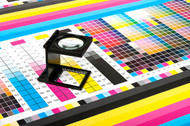5 Ways to Use a Printer’s Loupe Magnifier in the Printing Industry
20th Dec 2024
When it comes to checking the details of printed documents, specialists in the printing business rely on a loupe magnifier, which is a piece of equipment that is both compact and powerful. The use of a printing loupe helps to verify that the final output exceeds high-quality requirements by performing tasks such as examining the sharpness of the text, determining the correctness of the colors, and locating any minute printing faults. In this blog, we’ll explore five practical ways to use a printer’s magnifying glass to achieve better results in the printing industry.
What is a Loupe Magnifier?
A loupe magnifier is a small, handheld tool with a powerful lens that magnifies small details. It is widely used in fields that need to be precise, like printing, photos, and jewelry.
In the printing industry, a loupe is often referred to as a printing loupe or a printer’s magnifying glass. It helps professionals see fine details that are not visible to the naked eye, such as tiny dots, text alignment, and color variations.
Printers can use a loupe magnifier to discover and resolve issues such as fuzzy resolution, color mismatches, and print errors. This guarantees that the finished result is polished, professional, and satisfies the client's expectations.
5 Ways to Use a Loupe Magnifier in the Printing Industry
Here are five important ways professionals use a loupe magnifier to improve print quality:
1. Inspecting Print Resolution
Printer resolution, which is given in DPI (dots per inch), tells you how clear a picture or word is on printed material. Higher DPI means the print is better and sharper.
A printing loupe allows you to inspect the tiny dots that make up an image or text. Examining these elements will help you to see whether the resolution is constant and correct.
- Why is this important? Sharp resolution is essential for professional print jobs like brochures, magazines, and packaging. If the resolution is too low, the print may look blurry or pixelated, which lowers the quality of the final product.
- For instance, a loupe magnifier may be implemented by a designer to evaluate the print quality of a premium magazine cover. This guarantees that the text and images are in precise focus, with no discernible pixelation.
2. Checking Color Accuracy
In the printing industry, color consistency is critical, especially for businesses that rely on brand colors. A slight color shift can make printed materials look unprofessional and inconsistent.
A printer’s magnifying glass helps professionals inspect colors in fine detail. By zooming in on the ink patterns, you can see if the colors match the intended design or if there are any shifts in tone.
- Exactly why is this significant? Color mismatches can hurt the image of a brand. Making sure the colors are correct helps keep all written papers consistent.
- Example: A printing professional uses a loupe magnifier to check if the colors on a company’s flyers match their brand guidelines. This ensures the printed materials reflect the company’s identity perfectly.
3. Aligning Text and Images
Text and image alignment is a key factor in producing clean, professional prints. Even small misalignments can make printed materials look untidy and poorly designed.
Using a loupe magnifier, you can detect tiny shifts in alignment that might not be visible to the naked eye. By carefully inspecting text and images, you can ensure everything is positioned perfectly.
- Why is this noteworthy? Newspapers, business cards, and promotional materials all depend on a clean and professional appearance created by proper alignment.
- A print operator checks the alignment of text and images on a newspaper page with a printing loupe. The plan will look clean and well-organized this way.
4. Identifying Printing Defects
Printing defects, such as ink smudges, uneven coverage, or missing details, can negatively impact the final product’s quality. It's hard to see these problems with the naked eye because they happen so often during the printing process.
A printing loupe helps professionals magnify and identify these defects. By catching problems early, they can make adjustments and prevent costly mistakes.
- Why is this important? Identifying defects ensures that only high-quality prints are delivered to clients. This saves time, money, and resources.
- For example, a printing tech checks signs for ink smudges with a loupe lens. They can fix the problem and make clean prints without any mistakes if they find it early.
5. Looking at the quality and finish of the paper
Professional pictures also depend on the type of paper used and its finish, such as whether it is shiny, matte, or textured. With a loupe magnifier, you can look closely at the surface and finished features of the paper.
By using the loupe, you can check for flaws like rough edges, uneven coatings, or improper finishes that might affect the print’s appearance.
- For example, a package artist looks at the finish on high-end product packaging with the magnifying glass that comes with printers. This makes sure that the finish and appearance are always the same and look good.
- Example: A packaging designer uses a printer’s magnifying glass to inspect the finish on luxury product packaging. This ensures the texture and coating are consistent and visually appealing.
Conclusion
A loupe magnifier is an invaluable printing press parts for professionals in the printing industry. It lets you look at even the smallest features that can change the quality of printed materials. A printing loupe is an important tool for getting clear, sharp prints, making sure colors are correct for brand consistency, matching text and pictures correctly, finding printing mistakes, and checking the quality of the paper and finishing. By using a printer’s magnifying glass, professionals can catch and correct issues early, ensuring that the final product looks polished, professional, and meets client expectations. Incorporating a loupe magnifier into your workflow can help deliver precise, consistent, and visually appealing prints every time.



